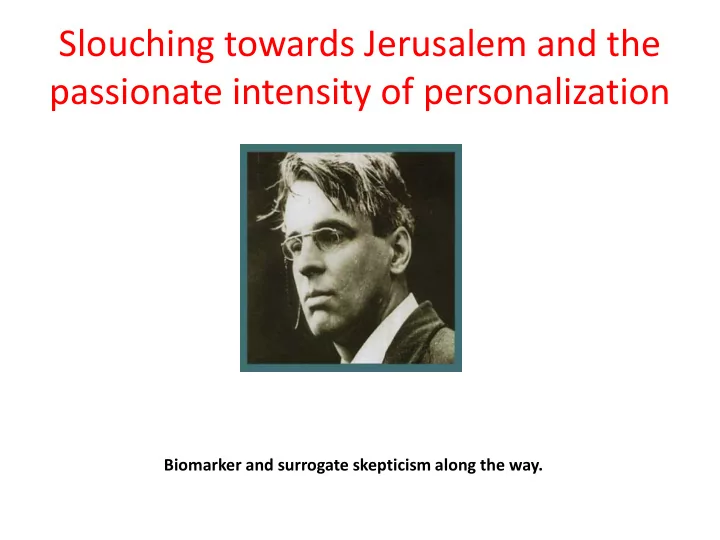

Slouching towards Jerusalem and the passionate intensity of personalization Biomarker and surrogate skepticism along the way.
Elevation in BP as a biomarker of risk and reduction of BP as a surrogate of risk modification • Ignored as a biomarker of risk as HDL was preferred as a biomarker of benefit – torcetrapib • Ignored as a biomarker of risk as benefits predicted to outweigh risk – bevacizumab. • Hailed as a “mechanism” of risk which with treatment would attenuate risk – celecoxib and rofecoxib.
FitzGerald GA TiPS 2007.
Inhibition of prostacyclin synthesis by celecoxib and rofecoxib 160 160 160 ( pg/mg Creatinine) 120 120 120 PGI-M ± SE 80 80 80 * † † † † † 40 40 40 n=7 n=7 n=7 n=12 n=12 n=10 n=50 n=50 n=50 0 0 0 Placebo Celecoxib Ibuprofen Placebo Rofecoxib Celecoxib Placebo Rofecoxib Indomethacin 400 mg 800 mg 25 mg 200 mg 50 mg qd 50 mg tid McAdam et al. Catella-Lawson et al. Fries et al Gastroenterology PNAS. 1999;96:272 JPET . 1999;289:735. 130:55-64, 2006 1 PGI-M = 2,3-dinor-6-keto-PGF 1 α ; † P <0.01 vs Placebo; * P <0.05 vs Placebo.
Prostacyclin modulates the Bioactivity of Thromboxane 7.5 1.5 wild type wild type Urinary 2,3 dinor TxB 2 * intima area / media area knock-out knock-out * (Fold over basal) 5.0 1.0 * 2.5 0.5 * 0.0 0.0 IP IP TP TP IPTP IPTP * p<0.05 vs. wild type Cheng et al., Science 296:593, 2002
Vascular COX-2 restrains Thrombogenesis Yu et al unpublished
Deletion of Vascular COX-2 elevates Blood Pressure * Normal diet 140 * High salt diet # Systolic BP (mmHg) # # 130 # 120 110 14 7 13 11 100 VSM KO EC KO VSM/EC KO Flox Ctr Yu Y. et al unpublished #, p<0.01, paired t test, *, p<0.05, unpaired t test, n=7-14
Vascular COX-2 contributes to Urinary PGI-M *** * P=.0.057 4 * * ng/mg Creatinine 3 PGI-M 2 1 Flox Ctr EC KO VSM KO VSM/EC KO *, p<0.05; ***, p<0.001, n=16-22
Inverse correlation between BP and PGI 2 in EC and VSMC COX-2 KOs PGI-BP 4.5 R 2 =0.2313 4.0 *, P=0.0105 3.5 3.0 PGI-M 2.5 2.0 1.5 1.0 0.5 0.0 100 110 120 130 140 150 BP Yi et al 2008
Magic Markers? • Depressed PGIM predicted CV hazard and all elements of the human phenotype recapitulated in mice by disruption of the COX-2 dependent formation of PGI 2 • Manifestation of hazard relates to drug exposure, concomitant therapies and underlying CV risk • Other biological systems promote and restrain hemostasis, hypertension, arrhythmogenesis etc • How big is the variability problem?
Interindividual variability in the pharmacological response to COX-2 inhibition COX-1 activity ex vivo 700 Attained COX-2 selectivity 600 500 Serum TxB 2 400 (COX-2 inhibition / COX-1 inhibition) 20 300 10 200 5 Cox-2 selectivity 100 2 hours 0 4 SS 0 SS 4 1 Single dose steady state 0.5 COX-2 activity ex vivo 0.2 50 40 30 Serum PGE 2 20 Placebo rofecoxib celecoxib (25 mg) (200 mg) 10 n=50 n=50 n=50 Fries, Grosser, FitzGerald, Gastroenterology, 2006 0 4 SS 0 SS 4 hours Single dose steady state
Genetic contribution to interindividual variability 3000 CYP2C9*3 +/+ Celecoxib [ng/ml] 2000 1000 0 0 4 8 12 24 36 Time after last dose (hrs) 3000 Celecoxib [ng/ml] CYP2C9*3 +/- 2000 1000 0 0 4 8 12 24 36 Time after last dose (hrs) Fries, Grosser, FitzGerald, Gastroenterology, 2006
The Challenge of Personalization • The contribution of genomics to variability in drug response was ~ 30% in healthy male volunteers under controlled conditions. • How do we predict analgesic efficacy and cardiovascular risk? • How do we detect emerging risk? • How do we confer benefit that is incremental to clinical practice?
The Personalized NSAID Therapeutics Consortium
PENTACON • Harness heterogeneous quantitative data from diverse model systems exposed to comparator NSAIDs at multiple doses • Utilize systems approaches, progressively populated with human data to develop models that result in novel predictive hypotheses • Test these hypotheses prospectively at scale.
Personalization of NSAID Therapy Can we develop algorithms which, when populated with an individual’s pre- and post test drug exposure can predict (i) whether they should take and NSAID and (ii) if so which drug, at what dose and for how long? The Time 100. http://www.time.com, 2008
The Personalized NSAID Therapeutics Consortium Integrated Data Technology Experimentation Management Systems Molecular Profiling Pharmacology Logistics High Throughput Zebrafish Models Curation Sequencing Database and Biomedical Imaging Mouse Models Integration Human Biology (I, II, III) Administrative Data Analysis and Interpretation Core Systems (I), Steering Population Modeling and Committee Pharmacology Computation (II) External Advisory Committee Data Visualization, Sharing and Education www.pentaconhq.org Healthcare providers, research community, and the public
Heterogeneity of nonsteroidal antiinflammatory drugs
Prostacyclin modulates the cadiovascular response to thromboxane in vivo Cheng et al Science 296: 539 – 541, 2002
Genetic contribution to interindividual variability (ii) Celecoxib Rofecoxib Fries, Grosser, FitzGerald, Gastroenterology, 2006
IT’S NOT A SIMPLE “BALANCE”
Confirmed Thrombotic Endpoint Kaplan-Meier Estimates (95% CI) Cumulative Incidence(%) with 95% CI 8 Placebo RR(95% CI): 1.96 (1.20, 3.19)* Rofecoxib 25mg 6 4 2 0 0 6 12 18 24 30 36 Month Patients at Risk Placebo 1299 1192 1148 1079 1039 1002 470 Rofecoxib 25 mg 1287 1123 1050 986 935 898 411 * p<0.05
NSAIDs: Non-Steroidal Antiinflammatory Drugs - Non-steroidal antiinflammatory drugs (NSAIDs) are the most commonly used pain killers in the world. Approximately 1000 NSAID containing drugs exist. - 46 million U.S. adults with arthritis use an NSAID regularly or intermittently for pain control - Some patients will have severe complications on NSAIDs: all NSAIDs can cause: stomach ulcers, gastrointestinal bleeds, hypertension some NSAIDs can cause: heart attack and stroke
Recommend
More recommend